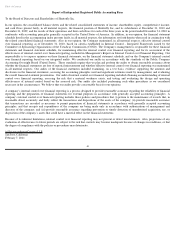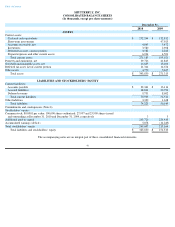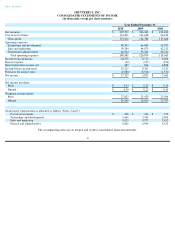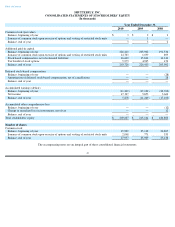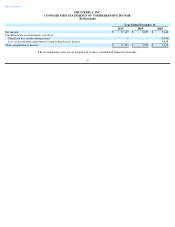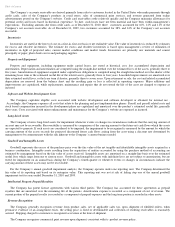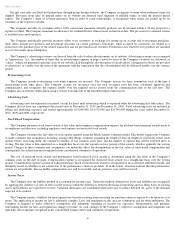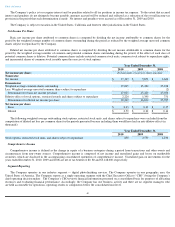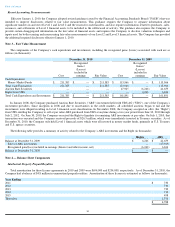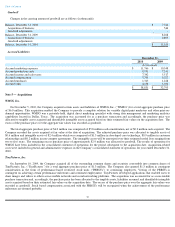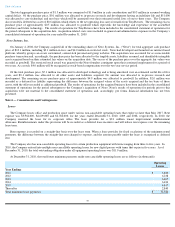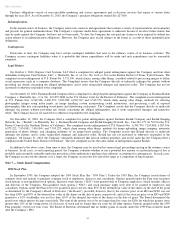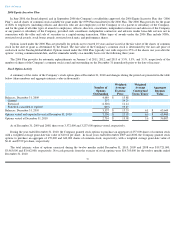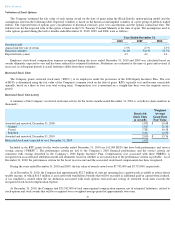Shutterfly 2011 Annual Report Download - page 56
Download and view the complete annual report
Please find page 56 of the 2011 Shutterfly annual report below. You can navigate through the pages in the report by either clicking on the pages listed below, or by using the keyword search tool below to find specific information within the annual report.
For gift card sales and flash deal promotions through group buying websites, the Company recognizes revenue when redeemed items are
shipped. Revenues from sales of prepaid orders on its website are deferred until shipment of fulfilled orders or until the prepaid period
expires. The Company’
s share of revenue generated from its print to retail relationships, is recognized when orders are picked up by its
customers at the respective retailer.
The Company provides its customers with a 100% satisfaction guarantee whereby products can be returned within a 30-
day period for a
reprint or refund. The Company maintains an allowance for estimated future returns based on historical data. The provision for estimated returns
is included in accrued expenses.
The Company periodically provides incentive offers to its customers in exchange for setting up an account and to encourage purchases.
Such offers include free products and percentage discounts on current purchases. Discounts, when accepted by customers, are treated as a
reduction to the purchase price of the related transaction and are presented in net revenues. Production costs related to free products are included
in cost of revenues upon redemption.
The Company’
s advertising revenues are derived from the sale of online advertisements on its website. Advertising revenues are recognized
as “impressions” (
i.e., the number of times that an advertisement appears in pages viewed by users of the Company's website) are delivered; as
“clicks” (which are generated each time users of our website click through the advertisements to an advertiser’
s designated website) are provided
to advertisers; or ratably over the term of the agreement with the expectation that the advertisement will be delivered ratably over the contract
period.
Restructuring Costs
The Company records restructuring costs when expenses are incurred. The Company accrues for lease termination costs at the time a
restructuring event takes place. The Company accrues for severance once the total severance pool has been calculated, approved and
communicated, and recognizes the expense ratably over the required service period, from the communication date to the exit date. The
Company also accelerates depreciation using a revised economic life of the leasehold improvement assets.
Advertising Costs
Advertising costs are expensed as incurred, except for direct mail advertising which is expensed when the advertising first takes place. The
Company did not have any capitalized direct mail costs at December 31, 2010 and December 31, 2009. Total advertising costs are included in
selling and marketing expenses and totaled approximately $15,849,000, $14,576,000 and $14,740,000 during the years ended December 31,
2010, 2009 and 2008, respectively.
Stock-Based Compensation
The Company measures stock based awards at fair value and recognizes compensation expense for all share-
based payment awards made to
its employees and directors, including employee stock options and restricted stock awards.
The Company estimates the fair value of stock options granted using the Black-
Scholes valuation model. This model requires the Company
to make estimates and assumptions including, among other things, estimates regarding the length of time an employee will retain vested stock
options before exercising them, the estimated volatility of our common stock price and the number of options that will be forfeited prior to
vesting. The fair value is then amortized on a straight-
line basis over the requisite service periods of the awards, which is generally the vesting
period. Changes in these estimates and assumptions can materially affect the determination of the fair value of stock-
based compensation and
consequently, the related amount recognized in our consolidated statements of operations.
The cost of restricted stock awards and performance based restricted stock awards is determined using the fair value of the Company’
s
common stock on the date of grant. Compensation expense is recognized for restricted stock awards on a straight-
line basis over the vesting
period. Compensation expense associated with performance based restricted stock awards is recognized on an accelerated attribution model, and
ultimately based on whether or not satisfaction of the performance criteria is probable. If in the future, situations indicate that the performance
criteria are not probable, then no further compensation cost will be recorded, and any previous costs will be reversed.
Income Taxes
The Company uses the liability method of accounting for income taxes. Under this method, deferred tax assets and liabilities are recognized
by applying the statutory tax rates in effect in the years in which the differences between the financial reporting and tax filing bases of existing
assets and liabilities are expected to reverse. Valuation allowances are established when necessary to reduce deferred tax assets to the amounts
expected to be realized.
The Company reports a liability for unrecognized tax benefits resulting from uncertain tax positions taken or expected to be taken in a tax
return. The application of income tax law is inherently complex. Laws and regulations in this area are voluminous and are often ambiguous. The
Company is required to make subjective assumptions and judgments regarding its income tax exposures. Interpretations and guidance
surrounding income tax laws and regulations change over time. As such, changes in the Company’
s subjective assumptions and judgments can
materially affect amounts recognized in the consolidated balance sheets and statements of operations.
Table of Contents
48



